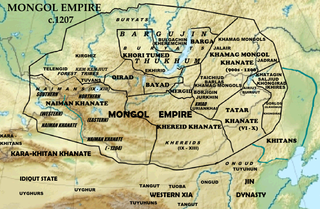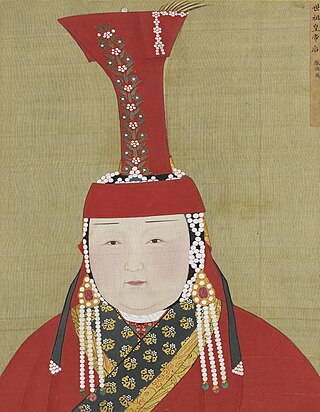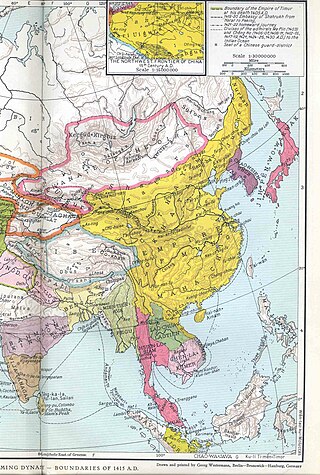
Throughout Chinese history, "Emperor" was the superlative title held by the monarchs who ruled various imperial dynasties. In traditional Chinese political theory, the emperor was the "Son of Heaven", an autocrat with the divine mandate right to rule all under Heaven. Emperors were worshiped posthumously under an imperial cult. The lineage of emperors descended from a paternal family line constituted a dynasty, and succession in most cases theoretically followed agnatic primogeniture.

A Borjigin is a member of the Mongol sub-clan that started with Bodonchar Munkhag of the Kiyat clan. Yesugei's descendants were thus said to be Kiyat-Borjigin. The senior Borjigids provided ruling princes for Mongolia and Inner Mongolia until the 20th century. The clan formed the ruling class among the Mongols and some other peoples of Central Asia and Eastern Europe. Today, the Borjigid are found in most of Mongolia, Inner Mongolia and Xinjiang, and genetic research has shown that descent from Genghis Khan and Timur is common throughout Central Asia and other regions.
Khutugtu Khan, born Ligdan, (1588–1634) was a khagan of the Northern Yuan dynasty, reigning from 1604 to 1634. During his reign, he vigorously attempted to reunify the divided Mongol Empire, achieving moderate levels of success. However, his unpopular reign generated violent opposition due to his harsh restrictions over the Mongol tribes as he attempted to centralize the state. His alliance with the Ming dynasty, sponsorship of Tibetan Buddhism in Chakhar and the reorganization of Mongol political divisions were ineffective when the Later Jin dynasty became the major power in East Asia.

The Ming dynasty considered Tibet to be part of the Western Regions. While the Ming dynasty at its height had some degree of influence in Tibet, the exact nature of their relations is under dispute by modern scholars. Analysis of the relationship is further complicated by modern political conflicts and the application of Westphalian sovereignty to a time when the concept did not exist. The Historical Status of China's Tibet, a book published by the People's Republic of China, asserts that the Ming dynasty had unquestioned sovereignty over Tibet by pointing to the Ming court's issuing of various titles to Tibetan leaders, Tibetans' full acceptance of the titles, and a renewal process for successors of these titles that involved traveling to the Ming capital. Scholars in China also argue that Tibet has been an integral part of China since the 13th century and so it was a part of the Ming Empire. However, most scholars outside China, such as Turrell V. Wylie, Melvyn C. Goldstein, and Helmut Hoffman, say that the relationship was one of suzerainty, Ming titles were only nominal, Tibet remained an independent region outside Ming control, and it simply paid tribute until the Jiajing Emperor, who ceased relations with Tibet.
Örüg Temür Khan, possibly Guilichi, (?–1408) was a khagan of the Northern Yuan dynasty, reigning from 1402 to 1408. Örüg Temür in historical materials compiled by the Timurid dynasty have been a descendant of Ögedei. Örüg Temür might also have been descended from either Ariq Böke or Genghis Khan's younger brothers, either Hasar or Temüge.
Bolad, was an ethnic Mongol minister of the Yuan dynasty of China, and later served in the Ilkhanate as the representative of the Great Khan of the Mongol Empire and cultural adviser to the Ilkhans. He also provided valuable information to Rashid-al-Din Hamadani to write about the Mongols. Mongolists consider him a cultural bridge between East and West. He was ennobled by Emperor Renzong of Yuan as Duke of Ze (澤國公) in 1311 and Prince of Yongfeng (永豐郡王) in 1313, posthumously.

The Yuan dynasty, officially the Great Yuan, was a Mongol-led imperial dynasty of China and a successor state to the Mongol Empire after its division. It was established by Kublai, the fifth khagan-emperor of the Mongol Empire from the Borjigin clan, and lasted from 1271 to 1368. In Chinese history, the Yuan dynasty followed the Song dynasty and preceded the Ming dynasty.

The Northern Yuan was a dynastic regime ruled by the Mongol Borjigin clan based in the Mongolian Plateau. It existed as a rump state after the collapse of the Yuan dynasty in 1368 and lasted until its conquest by the Jurchen-led Later Jin dynasty in 1635. The Northern Yuan dynasty began with the retreat of the Yuan imperial court led by Toghon Temür to the Mongolian steppe. This period featured factional struggles and the often only nominal role of the Great Khan.

Kublai Khan, also known by his temple name as the Emperor Shizu of Yuan and his regnal name Setsen Khan, was the founder and first emperor of the Mongol-led Yuan dynasty of China. He proclaimed the dynastic name "Great Yuan" in 1271, and ruled Yuan China until his death in 1294.
Various nomadic empires, including the Xiongnu, the Xianbei state, the Rouran Khaganate (330–555), the First (552–603) and Second Turkic Khaganates (682–744) and others, ruled the area of present-day Mongolia. The Khitan people, who used a para-Mongolic language, founded an empire known as the Liao dynasty (916–1125), and ruled Mongolia and portions of North China, northern Korea, and the present-day Russian Far East.
The Yuan dynasty (1271–1368) was a dynasty of China ruled by the Mongol Borjigin clan. Founded by Kublai Khan, it is considered one of the successors to the Mongol Empire.

Chabi was a Khongirad empress consort of the Mongol-led Yuan dynasty of China, married to Kublai Khan.

The House of Zhao was the imperial clan of the Song dynasty (960–1279) of China.

The Legend of Kublai Khan, also known as Legend of Yuan Empire Founder, is a Chinese television series based on the life of Kublai Khan and the events leading to the establishment of the Mongol-led Yuan dynasty in China. The series started shooting in 2011. It premiered at the 2013 Shanghai Television Festival from 11 to 13 June 2013, and was first aired on HBS from 21 to 30 July 2013. The series was directed by Tsui Siu-ming and starred Hu Jun and Charmaine Sheh as Kublai Khan and Chabi, along with Cai Wenyan, Wu Yue, Tang Guoqiang, Gao Fa, Steven Ma and Ray Lui in supporting roles.
The division of the Mongol Empire began after Möngke Khan died in 1259 in the siege of Diaoyu Castle with no declared successor, precipitating infighting between members of the Tolui family line for the title of khagan that escalated into the Toluid Civil War. This civil war, along with the Berke–Hulagu war and the subsequent Kaidu–Kublai war, greatly weakened the authority of the great khan over the entirety of the Mongol Empire, and the empire fractured into four khanates: the Golden Horde in Eastern Europe, the Chagatai Khanate in Central Asia, the Ilkhanate in Southwest Asia, and the Yuan dynasty in East Asia based in modern-day Beijing – although the Yuan emperors held the nominal title of khagan of the empire.

The Yuan dynasty in Inner Asia was the domination of the Yuan dynasty in Inner Asia in the 13th and the 14th centuries. The Borjigin rulers of the Yuan came from the Mongolian steppe, and the Mongols under Kublai Khan established the Yuan dynasty (1271–1368) based in Khanbaliq. The Yuan was a Chinese dynasty that incorporated many aspects of Mongol and Inner Asian political and military institutions.

The Later Jin, officially known as Jin or the Great Jin, was a Jurchen-led royal dynasty of China in Manchuria and the precursor to the Qing dynasty. Established in 1616 by the Jianzhou Jurchen chieftain Nurhaci upon his reunification of the Jurchen tribes, its name was derived from the earlier Jin dynasty founded by the Wanyan clan which had ruled northern China in the 12th and 13th centuries.

The debate on the "Chineseness" of the Yuan and Qing dynasties is concerned with whether the Mongol-led Yuan dynasty (1271–1368) and the Manchu-led Qing dynasty (1644–1912) can be considered "Chinese dynasties", and whether they were representative of "China" during the respective historical periods. The debate, albeit historiographical in nature, has political implications. Mainstream academia and successive governments of China, including the imperial governments of the Yuan and Qing dynasties, have maintained the view that they were "Chinese" and representative of "China". In short, the cause of the controversy stems from the dispute in interpreting the relationship between the two concepts of "Han Chinese" and "China", because although the Chinese government recognizes 56 ethnic groups in China and the Han have a more open view of the Yuan and Qing dynasties since Liang Qichao and other royalist reformers supported the Qing dynasty, the Han are China's main ethnic group. This means that there are many opinions that equate Han Chinese people with China and lead to criticism of the legitimacy of these two dynasties.

The Ming dynasty in Inner Asia was the expansion of the Ming dynasty's realm and influence in Inner Asia between the 14th and the 16th centuries. The Ming dynasty overthrew and succeeded the Mongol-led Yuan dynasty and sought to avert further incursions by a regime originating from Inner Asia. Wars were fought against the Northern Yuan, which existed as a rump state after the collapse of the Yuan dynasty in 1368, but also against other states in Inner Asia including the Oirat Confederation and Moghulistan. As a result, Ming China at the height incorporated Manchuria, much of the regions of Inner Mongolia and Qinghai, and parts of Xinjiang into its realm, and also had some degree of influence in Tibet especially during the reign of the Yongle Emperor.




































































